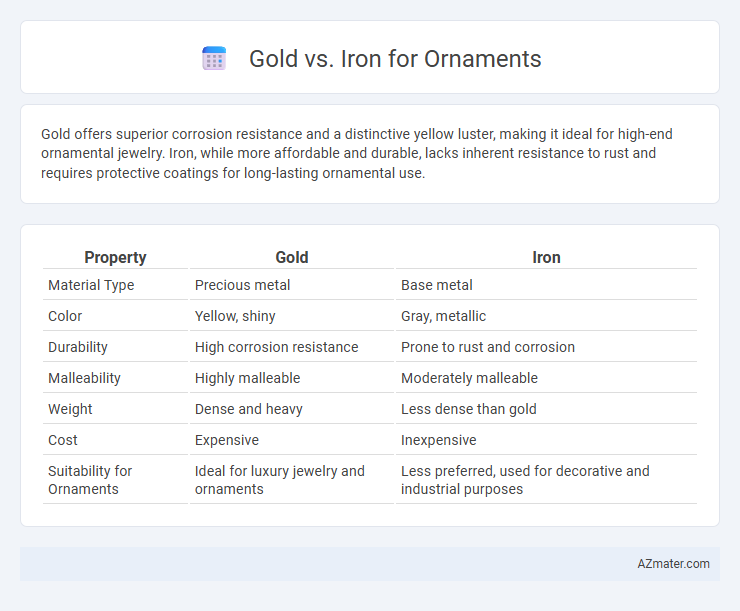Gold offers superior corrosion resistance and a distinctive yellow luster, making it ideal for high-end ornamental jewelry. Iron, while more affordable and durable, lacks inherent resistance to rust and requires protective coatings for long-lasting ornamental use.
Table of Comparison
| Property | Gold | Iron |
|---|---|---|
| Material Type | Precious metal | Base metal |
| Color | Yellow, shiny | Gray, metallic |
| Durability | High corrosion resistance | Prone to rust and corrosion |
| Malleability | Highly malleable | Moderately malleable |
| Weight | Dense and heavy | Less dense than gold |
| Cost | Expensive | Inexpensive |
| Suitability for Ornaments | Ideal for luxury jewelry and ornaments | Less preferred, used for decorative and industrial purposes |
Introduction: Gold vs Iron in Ornamentation
Gold and iron serve distinctly different roles in ornamentation due to their unique physical properties and cultural significance. Gold is prized for its luster, malleability, and resistance to tarnish, making it a timeless choice for intricate jewelry and ceremonial pieces. Iron, although less valuable and more prone to corrosion, is valued in ornamental use for its durability and historical symbolism in rustic or industrial designs.
Historical Significance of Gold and Iron Ornaments
Gold ornaments have historically symbolized wealth, power, and divine connection across civilizations such as Ancient Egypt and the Roman Empire, often used in royal regalia and religious artifacts. Iron ornaments, while less prestigious, represent durability and strength, reflecting the technological advancements of the Iron Age and the cultural valorization of warriors and blacksmiths in societies like the Celts and early Asian cultures. The contrasting historical significance of gold and iron ornaments underscores their roles in status expression and cultural identity from antiquity to medieval times.
Physical Properties: Gold Compared to Iron
Gold exhibits a distinctive malleability and ductility far surpassing iron, allowing intricate and delicate designs in ornaments without cracking. Unlike iron, gold is highly resistant to corrosion and tarnish, maintaining its luster and durability over long periods. The density of gold, nearly twice that of iron, gives gold ornaments a substantial and luxurious weight that is prized in high-end jewelry.
Aesthetic Appeal: Lustre and Color Differences
Gold's rich yellow hue offers a warm, radiant lustre that enhances its aesthetic appeal, making it a timeless choice for ornaments and jewelry. Iron, characterized by a darker, matte finish, lacks the natural brilliance of gold but can achieve varied appearances through finishing techniques such as polishing and coating. The vibrant shine and color consistency of gold contribute significantly to its preference in ornamental applications where visual impact is paramount.
Durability and Longevity in Jewelry
Gold exhibits superior corrosion resistance and maintains its luster over time, making it highly durable for jewelry intended to last generations. Iron, while strong, is prone to rust and tarnish when exposed to moisture and air, significantly reducing its longevity in ornaments. The inert nature of gold ensures minimal wear and tear, preserving intricate designs and enhancing the overall lifespan of jewelry pieces compared to iron.
Cultural and Symbolic Values
Gold symbolizes wealth, purity, and timeless elegance in ornamentation, often representing divine connection and social status across many cultures. Iron, while less prestigious, carries cultural values of strength, resilience, and protection, frequently used in traditional crafts and symbolic artifacts. The choice between gold and iron in ornaments reflects varying cultural narratives that emphasize either luxury and spiritual significance or durability and practical symbolism.
Cost and Market Value Analysis
Gold ornaments consistently command higher market value due to their rarity, intrinsic properties, and established demand in jewelry, often priced per gram significantly above iron. Iron, being abundant and inexpensive, offers a cost-effective alternative for ornaments but lacks the prestige and long-term value retention seen with gold. The cost differential is amplified by gold's resistance to corrosion and its status as a global investment asset, making it a preferred choice for high-value ornamental investments.
Maintenance and Care Requirements
Gold ornaments require minimal maintenance due to their resistance to tarnish and corrosion, making them ideal for daily wear and easy cleaning with mild soap and water. Iron ornaments demand more care as they are prone to rust and oxidation; regular cleaning, drying, and application of protective coatings like clear lacquer or oil are essential to preserve their appearance. Proper storage in dry environments further prevents iron from deteriorating, while gold's inherent durability reduces storage concerns.
Popularity and Trends in Modern Ornament Design
Gold remains the most popular metal for ornament design due to its timeless appeal, durability, and association with luxury, making it a preferred choice in both traditional and contemporary jewelry markets. Iron, while less common, is gaining attention in modern ornament trends for its industrial aesthetic and affordability, often featured in minimalist and avant-garde designs. The rising interest in sustainable and mixed-metal jewelry also boosts the integration of iron alongside gold, appealing to consumers seeking unique and eco-friendly fashion statements.
Conclusion: Choosing Between Gold and Iron Ornaments
Gold ornaments offer superior durability, natural resistance to tarnish, and intrinsic value that increases over time, making them ideal for long-term investment and luxury fashion. Iron ornaments provide affordability and a unique rustic aesthetic but require regular maintenance to prevent rust and wear, limiting their practicality for everyday use. Selecting between gold and iron ornaments depends on prioritizing elegance and longevity versus cost-effectiveness and distinctive style.

Infographic: Gold vs Iron for Ornament
 azmater.com
azmater.com